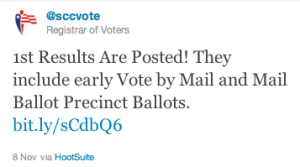
Santa Clara County voters last week were split on labor issues, school board members, council candidates and a composting facility. But there was one choice an overwhelming majority agreed upon: voting by mail.
Of the 44,403 votes cast Nov. 8 in Cupertino, Sunnyvale, Palo Alto, Orchard School District and Sunnyvale School District, more than 80 percent came via mail-in ballots, according to county election results.
Kim Alexander, founder and president of the California Voter Foundation, said it’s common to see a higher percentage of mail-in ballots in low-turnout elections. “I think that’s because there are about 3 [million] to 4 million people in the state who vote in every election, and many of those people are voting by mail,” she said.
Presidential elections, on the other hand, draw a larger number of occasional voters, who are less likely to register as permanent absentee voters.
The county’s acting registrar, Elaine Larson, said absentee ballots can be beneficial for voters, vote-counters and the public.
“The big difference is that by California law, we’re allowed to start opening and processing those ballots 10 calendar days before the election,” she said. With a big head start in the tabulations, the registrar’s office was able to post the first batch of results immediately after the polls closed.
The registrar’s Twitter account, @sccvote, announced at 8 p.m.: “1st Results Are Posted! They include early Vote by Mail and Mail Ballot Precinct Ballots.” It wasn’t known at the time, but some of the night’s races were already decided in that first count.
Palo Alto’s Measure D, for example, needed at least 50 percent — 7,632 votes — to pass. The absentee tally alone gave it 8,849 votes, so the regular and provisional ballots that were counted and posted over the hours and days that followed could not have changed the outcome.
Permanent absentee registration has been on the rise for years in California, and many county registrars have actively promoted the option. Larson said voting by mail can be easier and more convenient. It also offers voters more time to look over their choices and reduces the risk of forgetting or being too busy to vote.
Caitlin Stanton, a Palo Alto resident who votes by mail, said she sometimes misses the “community spirit” of the polling place. But as a mother of twins, she said, “it’s not realistic” to vote in person.
The convenience factor marks a shift from the original purpose of mail-in voting: mobility. Absentee ballots started out as a way to allow soldiers, the elderly and infirm to vote even if they couldn’t make it to a polling place. In 1978, California was the first state to extend that option to any voter; 26 other states have followed suit, according to the National Conference of State Legislatures.
Oregon and Washington now conduct all of their balloting by mail, a change that proponents say has reduced costs and boosted turnout.
Alexander said that system wouldn’t work for California. “We’re not Oregon or Washington. Our electorate is far more diverse,” she said. “There are a lot of people who benefit from poll-worker assistance.”
She also pointed out that Oregon has a “unified statewide voting system,” whereas in California, instructions and procedures can vary by county. Even policies set at the state level are sometimes implemented differently from one polling place to another, she said.
Santa Clara County’s Nov. 8 turnout would seem to indicate that absentee ballots increase voter turnout — the county got back 41.8 percent of the absentee ballots it distributed, while only 25.3 percent of non-absentee voters actually made it to their polling place.
But a recent study by the Pew Center on the States found that a mandatory vote-by-mail system in California would reduce an individual’s likelihood of voting by 13.2 percent, and have an even stronger dampening effect on urban and minority voters.
Critics of all-mail balloting also note that voters can confirm that their ballot was received, but they can’t always confirm that their vote was counted. They say many ballots have been misplaced in the mail, arrived after election day, or been disqualified because the voter did not sign the envelope.
In the 2008 primary election, 4.8 percent of absentee ballots submitted in Santa Clara County were not counted, according to data on the Secretary of State’s website. In the general election that followed, that rate dropped to 1.6 percent. Statewide, the percentages of uncounted absentee ballots for those elections were 2.5 and 2.8, respectively.
Absentee voting is “beneficial to those voters who are using it, but it’s not the solution for everyone,” Alexander said. Her foundation advocates a hybrid approach to election reform, both improving accountability in the absentee voting system and boosting efficiency in polling places.


Absentee voting is a time bomb.
According to this article, between 2.5% and 4.8% of absentee ballots failed, for one reason or another. Major elections, especially Presidential elections, are frequently decided by margins of less than one percent.
This means that sooner or later, we will have a situation where an election is decided by a few hundred votes, and there were several thousand votes not counted. It’s not going to be pretty.